Numerical Simulation and Analysis of Water and Suspended Sediment Transport in Hangzhou Bay, China
Abstract
:1. Introduction
2. Methods
2.1. Numerical Model
2.1.1. Hydrodynamic Model
2.1.2. Sediment Module
2.1.3. Wave Model
2.2. Model Validation
3. Results
3.1. Water Flux Transport
3.2. Suspended Sediment Transport
3.3. Water and Sediment Exchange Flux between the Changjiang Estuary and Hangzhou Bay
4. Discussion
4.1. Effect of Turbidity-Influenced Stratification and Bottom Drag Coefficient on Suspended Sediment Transport
4.2. Effect of Baroclinic Pressure Gradient Force on Suspended Sediment Transport
5. Conclusions
Author Contributions
Funding
Institutional Review Board Statement
Informed Consent Statement
Acknowledgments
Conflicts of Interest
References
- Fang, H.W.; Huang, L.; Wang, J.Y.; He, G.J.; Reible, D. Environmental assessment of heavy metal transport and transformation in the Hangzhou Bay, China. J. Hazard. Mater. 2016, 302, 447–457. [Google Scholar] [CrossRef] [PubMed]
- Huang, Y.G.; Yang, H.F.; Jia, J.J.; Li, P.; Zhang, W.X.; Wang, Y.P.; Ding, Y.F.; Dai, Z.J.; Shi, B.W.; Yang, S.L. Declines in suspended sediment concentration and their geomorphological and biological impacts in the Yangtze River Estuary and adjacent sea. Estuar. Coast. Shelf Sci. 2022, 265, 107708. [Google Scholar] [CrossRef]
- Zhao, X.; Wang, S.S.; Pan, C.H.; Mu, J.B.; Li, L.W.; Zhu, Y.Z. Distribution characteristics and ecological risk assessment of nutrients in sediment particles in Hangzhou Bay, China. In Proceedings of the IOP Conference Series: Earth and Environmental Science, Taiwan, China, 17–21 July 2018; p. 012079. [Google Scholar]
- Liu, G.F.; Zhu, J.R.; Wang, Y.Y.; Wu, H.; Wu, J.X. Tripod measured residual currents and sediment flux: Impacts on the silting of the Deepwater Navigation Channel in the Changjiang Estuary. Estuar. Coast. Shelf Sci. 2011, 93, 192–201. [Google Scholar] [CrossRef]
- Zhu, L.; He, Q.; Shen, J.; Wang, Y. The influence of human activities on morphodynamics and alteration of sediment source and sink in the Changjiang Estuary. Geomorphology 2016, 273, 52–62. [Google Scholar] [CrossRef]
- Song, Z.K.; Shi, W.Y.; Zhang, J.B.; Hu, H.; Zhang, F.; Xu, X. Transport Mechanism of Suspended Sediments and Migration Trends of Sediments in the Central Hangzhou Bay. Water 2020, 12, 2189. [Google Scholar] [CrossRef]
- Xie, D.F.; Pan, C.H.; Wu, X.G.; Gao, S.; Wang, Z.B. Local human activities overwhelm decreased sediment supply from the Changjiang River: Continued rapid accumulation in the Hangzhou Bay-Qiantang Estuary system. Mar. Geol. 2017, 392, 66–77. [Google Scholar] [CrossRef]
- Yang, S.L.; Zhang, J.M.; Zhu, J.; Smith, J.P.; Dai, S.B.; Gao, A.; Li, P. Impact of dams on Yangtze River sediment supply to the sea and delta intertidal wetland response. J. Geophys. Res. Earth Surf. 2005, 110. [Google Scholar] [CrossRef]
- Zhu, B.Y.; Li, Y.T.; Yu, W.J.; Sun, Z.H.; Deng, J.Y.; Chai, Y.F.; Zhang, C.C. An analysis of the processes and trends of changes in Yangtze River water and sediment fluxes into the ocean. Resour. Environ. Yangtze Basin 2019, 28, 2980–2991, (In Chinese with English Abstract). [Google Scholar]
- Cheng, L.; Jueyi, S.; Yun, H.; Hirshfield, F. Changes in runoff and sediment load from major Chinese rivers to the Pacific Ocean over the period 1955–2010. Int. J. Sediment Res. 2013, 28, 486–495. [Google Scholar]
- Chen, S.L. Seasonal, neap-spring variation of sediment concentration in the joint area between Yangtze Estuary and Hangzhou Bay. Sci. China Ser. B Chem. 2001, 44, 57–62. [Google Scholar] [CrossRef]
- Dai, Z.J.; Chu, A.; Li, W.H.; Li, J.F.; Wu, H.L. Has suspended sediment concentration near the mouth bar of the Yangtze (Changjiang) Estuary been declining in recent years? J. Coast. Res. 2013, 29, 809–818. [Google Scholar] [CrossRef]
- Li, P.; Yang, S.L.; Milliman, J.D.; Xu, K.H.; Qin, W.H.; Wu, C.S.; Chen, Y.P.; Shi, B.W. Spatial, temporal, and human-induced variations in suspended sediment concentration in the surface waters of the Yangtze Estuary and adjacent coastal areas. Estuaries Coasts 2012, 35, 1316–1327. [Google Scholar] [CrossRef] [Green Version]
- Luo, W.; Shen, F.; He, Q.; Cao, F.; Zhao, H.Y.; Li, M.Y. Changes in suspended sediments in the Yangtze River Estuary from 1984 to 2020: Responses to basin and estuarine engineering constructions. Sci. Total Environ. 2022, 805, 150381. [Google Scholar] [CrossRef]
- Alexander, C.R.; DeMaster, D.J.; Nittrouer, C.A. Sediment accumulation in a modern epicontinental-shelf setting: The Yellow Sea. Mar. Geol. 1991, 98, 51–72. [Google Scholar] [CrossRef]
- DeMaster, D.J.; McKee, B.A.; Nittrouer, C.A.; Jiangchu, Q.; Guodong, C. Rates of sediment accumulation and particle reworking based on radiochemical measurements from continental shelf deposits in the East China Sea. Cont. Shelf Res. 1985, 4, 143–158. [Google Scholar] [CrossRef]
- Guo, Z.G.; Yang, Z.S.; Fan, D.J.; Pan, Y.J. Seasonal sedimentary effect on the Changjiang Estuary mud area. Acta Geogr. Sin. 2003, 58, 591–597, (In Chinese with English Abstract). [Google Scholar]
- Sternberg, R.; Larsen, L.; Miao, Y. Tidally driven sediment transport on the East China Sea continental shelf. Cont. Shelf Res. 1985, 4, 105–120. [Google Scholar] [CrossRef]
- Liu, J.P.; Xu, K.H.; Li, A.C.; Milliman, J.D.; Velozzi, D.M.; Xiao, S.B.; Yang, Z.S. Flux and fate of Yangtze River sediment delivered to the East China Sea. Geomorphology 2007, 85, 208–224. [Google Scholar] [CrossRef]
- Cao, P.K.; Gu, G.C.; Dong, Y.F.; Hu, F.X. Basic characteristics of sediment transport in Hangzhou Bay. J. East China Norm. Univ. (Nat. Sci.) 1985, 3, 75–84, (In Chinese with English Abstract). [Google Scholar]
- Su, J.L.; Wang, K.S. Changjiang river plume and suspended sediment transport in Hangzhou Bay. Cont. Shelf Res. 1989, 9, 93–111. [Google Scholar]
- Xie, D.F.; Pan, C.H.; Wu, X.G.; Gao, S.; Wang, Z.B. The variations of sediment transport patterns in the outer C hangjiang E stuary and H angzhou B ay over the last 30 years. J. Geophys. Res. Ocean. 2017, 122, 2999–3020. [Google Scholar] [CrossRef]
- Dai, Z.J.; Liu, J.T.; Xie, H.L.; Shi, W.Y. Sedimentation in the outer Hangzhou Bay, China: The influence of Changjiang sediment load. J. Coast. Res. 2014, 30, 1218–1225. [Google Scholar] [CrossRef]
- Wang, B.C.; Eisma, D. Supply and deposition of sediment along the north bank of Hangzhou Bay, China. Neth. J. Sea Res. 1990, 25, 377–390. [Google Scholar] [CrossRef]
- Chen, J.Y.; Liu, C.Z.; Zhang, C.L.; Walker, H.J. Geomorphological development and sedimentation in Qiantang Estuary and Hangzhou Bay. J. Coast. Res. 1990, 6, 559–572. [Google Scholar]
- Xie, D.F.; Wang, Z.B.; Gao, S.; De Vriend, H.J. Modeling the tidal channel morphodynamics in a macro-tidal embayment, Hangzhou Bay, China. Cont. Shelf Res. 2009, 29, 1757–1767. [Google Scholar] [CrossRef]
- Du, P.J.; Ding, P.X.; Hu, K.L. Simulation of three-dimensional cohesive sediment transport in Hangzhou Bay, China. Acta Oceanol. Sin. 2010, 29, 98–106. [Google Scholar] [CrossRef]
- Xie, D.F.; Gao, S.; Wang, Z.B.; Pan, C.H. Numerical modeling of tidal currents, sediment transport and morphological evolution in Hangzhou Bay, China. Int. J. Sediment Res. 2013, 28, 316–328. [Google Scholar] [CrossRef]
- Hu, Y.K.; Yu, Z.F.; Zhou, B.; Li, Y.; Yin, S.J.; He, X.Q.; Peng, X.X.; Shum, C.K. Tidal-driven variation of suspended sediment in Hangzhou Bay based on GOCI data. Int. J. Appl. Earth Obs. Geoinf. 2019, 82, 101920. [Google Scholar] [CrossRef]
- Yang, X.F.; Mao, Z.H.; Huang, H.Q.; Zhu, Q.K. Using GOCI retrieval data to initialize and validate a sediment transport model for monitoring diurnal variation of SSC in Hangzhou Bay, China. Water 2016, 8, 108. [Google Scholar] [CrossRef]
- Wang, D.S.; Cao, A.Z.; Zhang, J.C.; Fan, D.D.; Liu, Y.Z.; Zhang, Y. A three-dimensional cohesive sediment transport model with data assimilation: Model development, sensitivity analysis and parameter estimation. Estuar. Coast. Shelf Sci. 2018, 206, 87–100. [Google Scholar] [CrossRef]
- Zhang, J.C.; Chu, D.D.; Wang, D.S.; Cao, A.Z.; Lv, X.Q.; Fan, D.d. Estimation of spatially varying parameters in three-dimensional cohesive sediment transport models by assimilating remote sensing data. J. Mar. Sci. Technol. 2018, 23, 319–332. [Google Scholar] [CrossRef]
- Blumberg, A.F. A Primer for ECOM-si; Technical Report; HydroQual, Inc.: Mahwah, NJ, USA, 1994; p. 66. [Google Scholar]
- Blumberg, A.F.; Mellor, G.L. A description of a three-dimensional coastal ocean circulation model. Three-Dimens. Coast. Ocean Models 1987, 4, 1–16. [Google Scholar]
- Arakawa, A.; Lamb, V.R. Computational design of the basic dynamical processes of the UCLA general circulation model. Gen. Circ. Models Atmos. 1977, 17, 173–265. [Google Scholar]
- Chen, C.S.; Zhu, J.R.; Zheng, L.Y.; Ralph, E.; Budd, J.W. A non-orthogonal primitive equation coastal ocean circulation model: Application to Lake Superior. J. Gt. Lakes Res. 2004, 30, 41–54. [Google Scholar] [CrossRef]
- Mellor, G.L.; Yamada, T.J. Development of a turbulence closure model for geophysical fluid problems. Rev. Geophys. 1982, 20, 851–875. [Google Scholar] [CrossRef]
- Smagorinsky, J. General circulation experiments with the primitive equations: I. The basic experiment. Mon. Weather Rev. 1963, 91, 99–164. [Google Scholar] [CrossRef]
- Wu, H.; Zhu, J.R. Advection scheme with 3rd high-order spatial interpolation at the middle temporal level and its application to saltwater intrusion in the Changjiang Estuary. Ocean Model. 2010, 33, 33–51. [Google Scholar] [CrossRef]
- Casulli, V.; Cattani, E. Stability, accuracy and efficiency of a semi-implicit method for three-dimensional shallow water flow. Comput. Math. Appl. 1994, 27, 99–112. [Google Scholar] [CrossRef] [Green Version]
- Wu, H.; Zhu, J.R.; Shen, J.; Wang, H. Tidal modulation on the Changjiang River plume in summer. J. Geophys. Res. Ocean. 2011, 116. [Google Scholar] [CrossRef]
- Mellor, G.L.; Yamada, T.J. A hierarchy of turbulence closure models for planetary boundary layers. J. Atmos. Sci. 1974, 31, 1791–1806. [Google Scholar] [CrossRef]
- Song, D.H.; Wang, X.H. Suspended sediment transport in the Deepwater Navigation Channel, Yangtze River Estuary, China, in the dry season 2009: 2. Numerical simulations. J. Geophys. Res. Ocean. 2013, 118, 5568–5590. [Google Scholar] [CrossRef]
- Luo, Z.F.; Zhu, J.R.; Wu, H.; Li, X.Y. Dynamics of the sediment plume over the Yangtze Bank in the Yellow and East China Seas. J. Geophys. Res. Ocean. 2017, 122, 10073–10090. [Google Scholar] [CrossRef]
- Van Prooijen, B.C.; Winterwerp, J.C. A stochastic formulation for erosion of cohesive sediments. J. Geophys. Res. Ocean. 2010, 115. [Google Scholar] [CrossRef]
- Ge, J.Z.; Shen, F.; Guo, W.Y.; Chen, C.S.; Ding, P.X. Estimation of critical shear stress for erosion in the C hangjiang E stuary: A synergy research of observation, GOCI sensing and modeling. J. Geophys. Res. Ocean. 2015, 120, 8439–8465. [Google Scholar] [CrossRef]
- Lumborg, U. Modelling the deposition, erosion, and flux of cohesive sediment through Øresund. J. Mar. Syst. 2005, 56, 179–193. [Google Scholar] [CrossRef]
- Pandoe, W.W.; Edge, B.L. Case study for a cohesive sediment transport model for Matagorda Bay, Texas, with coupled ADCIRC 2D-transport and SWAN wave models. J. Hydraul. Eng. 2008, 134, 303–314. [Google Scholar] [CrossRef]
- Van Rijn, L.C. Principles of Sediment Transport in Rivers, Estuaries and Coastal Seas; Aqua Publications: Amsterdam, The Netherlands, 1993; Volume 1006. [Google Scholar]
- Shi, B.W.; Yang, S.L.; Wang, Y.P.; Bouma, T.J.; Zhu, Q. Relating accretion and erosion at an exposed tidal wetland to the bottom shear stress of combined current–wave action. Geomorphology 2012, 138, 380–389. [Google Scholar] [CrossRef]
- Mehta, A.J.; Lee, S.C. Problems in linking the threshold condition for the transport of cohesionless and cohesive sediment grain. J. Coast. Res. 1994, 10, 170–177. [Google Scholar]
- Taki, K. Critical shear stress for cohesive sediment transport. In Proceedings in Marine Science; Elsevier: Amsterdam, The Netherlands, 2000; Volume 3, pp. 53–61. [Google Scholar]
- Yang, M.Q.; Wang, G.L. The incipient motion formulas for cohesive fine sediments. J. Basic Sci. Eng. 1995, 3, 99–109, (In Chinese with English Abstract). [Google Scholar]
- Van Rijn, L.C. Unified view of sediment transport by currents and waves. I: Initiation of motion, bed roughness, and bed-load transport. J. Hydraul. Eng. 2007, 133, 649–667. [Google Scholar] [CrossRef] [Green Version]
- Fofonoff, N.P.; Millard, R.C., Jr. Algorithms for the Computation of Fundamental Properties of Seawater. Unesco Tech. Pap. Mar. Sci. 1983, 44, 53. [Google Scholar]
- Winterwerp, J.C. Stratification effects by cohesive and noncohesive sediment. J. Geophys. Res. Ocean. 2001, 106, 22559–22574. [Google Scholar] [CrossRef]
- Allen, G.P.; Salomon, J.C.; Bassoullet, P.; Du Penhoat, Y.; De Grandpre, C. Effects of tides on mixing and suspended sediment transport in macrotidal estuaries. Sediment. Geol. 1980, 26, 69–90. [Google Scholar] [CrossRef]
- Wang, X.H.; Byun, D.S.; Wang, X.L.; Cho, Y.K. Modelling tidal currents in a sediment stratified idealized estuary. Cont. Shelf Res. 2005, 25, 655–665. [Google Scholar] [CrossRef]
- Ge, J.Z.; Chen, C.S.; Wang, Z.B.; Ke, K.T.; Yi, J.X.; Ding, P.X. Dynamic response of the fluid mud to a tropical storm. J. Geophys. Res. Ocean. 2020, 125, e2019JC015419. [Google Scholar] [CrossRef]
- Ge, J.Z.; Zhou, Z.Y.; Yang, W.L.; Ding, P.X.; Chen, C.S.; Wang, Z.B.; Gu, J.H. Formation of concentrated benthic suspension in a time-dependent salt wedge estuary. J. Geophys. Res. Ocean. 2018, 123, 8581–8607. [Google Scholar] [CrossRef]
- Trowbridge, J.H.; Kineke, G.C. Structure and dynamics of fluid muds on the Amazon continental shelf. J. Geophys. Res. Ocean. 1994, 99, 865–874. [Google Scholar] [CrossRef]
- Wolanski, E.; Chappell, J.; Ridd, P.; Vertessy, R. Fluidization of mud in estuaries. J. Geophys. Res. Ocean. 1988, 93, 2351–2361. [Google Scholar] [CrossRef]
- Wang, X.H. Tide-induced sediment resuspension and the bottom boundary layer in an idealized estuary with a muddy bed. J. Geophys. Res. Ocean. 2002, 32, 3113–3131. [Google Scholar] [CrossRef]
- Hwang, K.N. Erodibility of Fine Sediment in Wave-Dominated Environments. Master’s Thesis, University of Florida, Gainesville, FL, USA, 1989. [Google Scholar]
- Mehta, A.J.; McAnally, W.H. Fine grained sediment transport. In Sedimentation Engineering: Processes, Measurements, Modeling, and Practice; American Society of Civil Engineers: Reston, VA, USA, 2008; pp. 253–306. [Google Scholar]
- Huang, S.; Han, N.; Zhong, X. Analysis of siltation at mouth bar of the Yangtze River Estuary. In Proceedings of the International Symposium on River Sedimentation, Beijing, China, 24–29 March 1980. [Google Scholar]
- Wang, X.H.; Pinardi, N. Modeling the dynamics of sediment transport and resuspension in the northern Adriatic Sea. J. Geophys. Res. Ocean. 2002, 107, 18-11–18-23. [Google Scholar] [CrossRef]
- Sternberg, R.W.; Berhane, I.; Ogston, A.S.J.M.G. Measurement of size and settling velocity of suspended aggregates on the northern California continental shelf. Mar. Geol. 1999, 154, 43–53. [Google Scholar] [CrossRef]
- Shi, Z.; Zhou, H.J. Controls on effective settling velocities of mud flocs in the Changjiang Estuary, China. Hydrol. Process. 2004, 18, 2877–2892. [Google Scholar] [CrossRef]
- Wan, Y.; Wu, H.; Roelvink, D.; Gu, F. Experimental study on fall velocity of fine sediment in the Yangtze Estuary, China. Ocean Eng. 2015, 103, 180–187. [Google Scholar] [CrossRef]
- Yang, Y.; Wang, Y.P.; Li, C.; Gao, S.; Shi, B.; Zhou, L.; Wang, D.; Li, G.; Dai, C. On the variability of near-bed floc size due to complex interactions between turbulence, SSC, settling velocity, effective density and the fractal dimension of flocs. Geo-Mar. Lett. 2016, 36, 135–149. [Google Scholar] [CrossRef]
- McAnally, W.H.; Teeter, A.; Schoellhamer, D.; Friedrichs, C.; Hamilton, D.; Hayter, E.; Shrestha, P.; Rodriguez, H.; Sheremet, A.; Kirby, R. Management of fluid mud in estuaries, bays, and lakes. II: Measurement, modeling, and management. J. Hydraul. Eng. 2007, 133, 23–38. [Google Scholar] [CrossRef]
- Costa, R.G.; Mehta, A.J. Flow-fine sediment hysteresis in sediment-stratified coastal waters. In Coastal Engineering; American Society of Civil Engineers: Reston, VA, USA, 1991; pp. 2047–2060. [Google Scholar]
- Wiberg, P.L.; Sherwood, C.R. Calculating wave-generated bottom orbital velocities from surface-wave parameters. Comput. Geosci. 2008, 34, 1243–1262. [Google Scholar] [CrossRef]
- Mellor, G.; Blumberg, A. Wave breaking and ocean surface layer thermal response. J. Phys. Oceanogr. 2004, 34, 693–698. [Google Scholar] [CrossRef]
- Booij, N.; Ris, R.C.; Holthuijsen, L.H. A third-generation wave model for coastal regions: 1. Model description and validation. J. Geophys. Res. Ocean. 1999, 104, 7649–7666. [Google Scholar] [CrossRef]
- Lyu, H.H.; Zhu, J.R. Impact of the bottom drag coefficient on saltwater intrusion in the extremely shallow estuary. J. Hydrol. 2018, 557, 838–850. [Google Scholar] [CrossRef]
- Qiu, C.; Zhu, J.R. Influence of seasonal runoff regulation by the Three Gorges Reservoir on saltwater intrusion in the Changjiang River Estuary. Cont. Shelf Res. 2013, 71, 16–26. [Google Scholar] [CrossRef]
- Murphy, A.H. Skill scores based on the mean square error and their relationships to the correlation coefficient. Mon. Weather Rev. 1988, 116, 2417–2424. [Google Scholar] [CrossRef]
- Warner, J.C.; Geyer, W.R.; Lerczak, J.A. Numerical modeling of an estuary: A comprehensive skill assessment. J. Geophys. Res. Ocean. 2005, 110. [Google Scholar] [CrossRef]
- Willmott, C.J. On the validation of models. Phys. Geogr. 1981, 2, 184–194. [Google Scholar] [CrossRef]
- Shen, F.; Zhou, Y.X.; Li, J.F.; He, Q.; Verhoef, W. Remotely sensed variability of the suspended sediment concentration and its response to decreased river discharge in the Yangtze estuary and adjacent coast. Cont. Shelf Res. 2013, 69, 52–61. [Google Scholar] [CrossRef]
- Shen, F.; Zhou, Y.X.; Peng, X.Y.; Chen, Y.L. Satellite multi-sensor mapping of suspended particulate matter in turbid estuarine and coastal ocean, China. Int. J. Remote Sens. 2014, 35, 4173–4192. [Google Scholar] [CrossRef]
- Bian, C.W.; Jiang, W.S.; Quan, Q.; Wang, T.; Greatbatch, R.J.; Li, W. Distributions of suspended sediment concentration in the Yellow Sea and the East China Sea based on field surveys during the four seasons of 2011. J. Mar. Syst. 2013, 121, 24–35. [Google Scholar] [CrossRef]

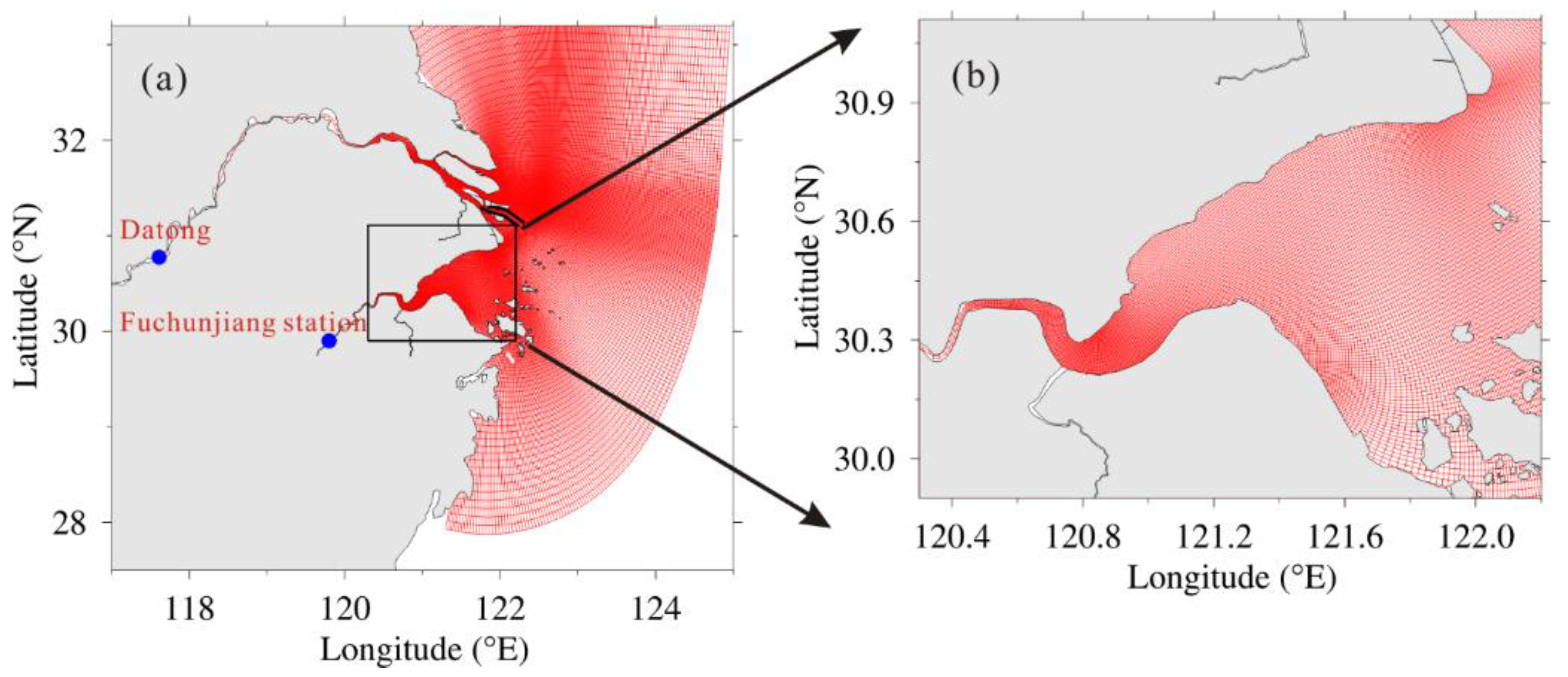


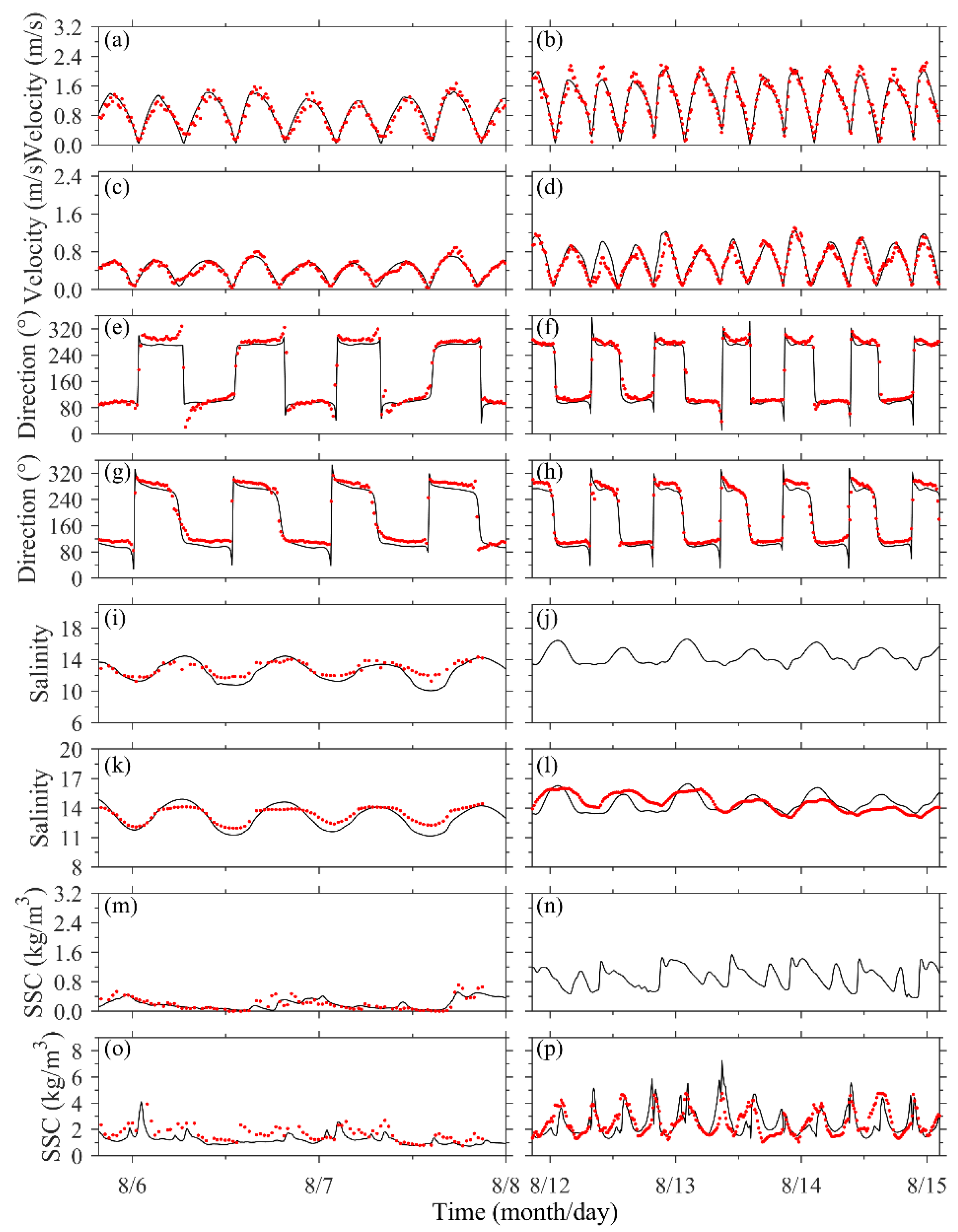
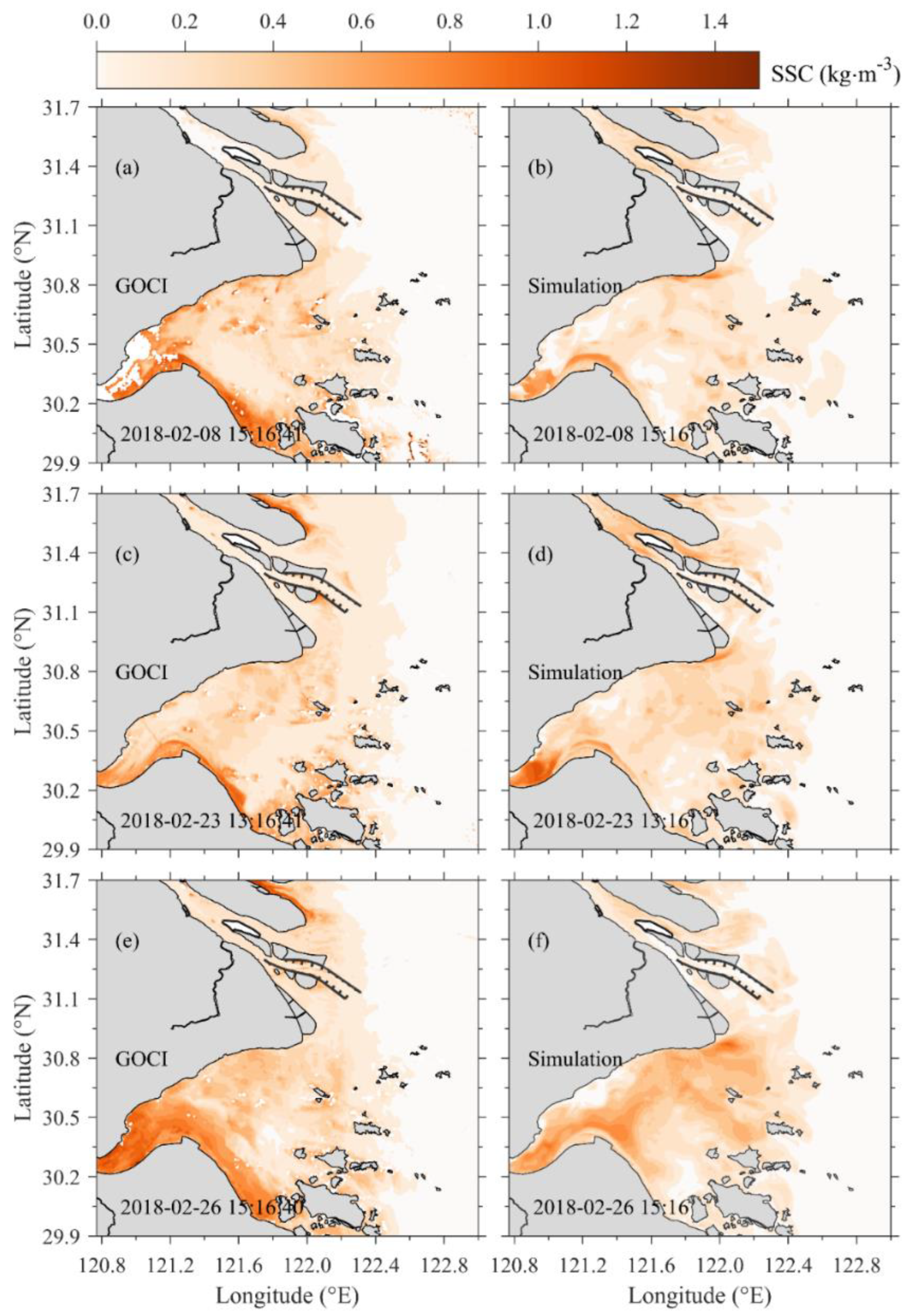
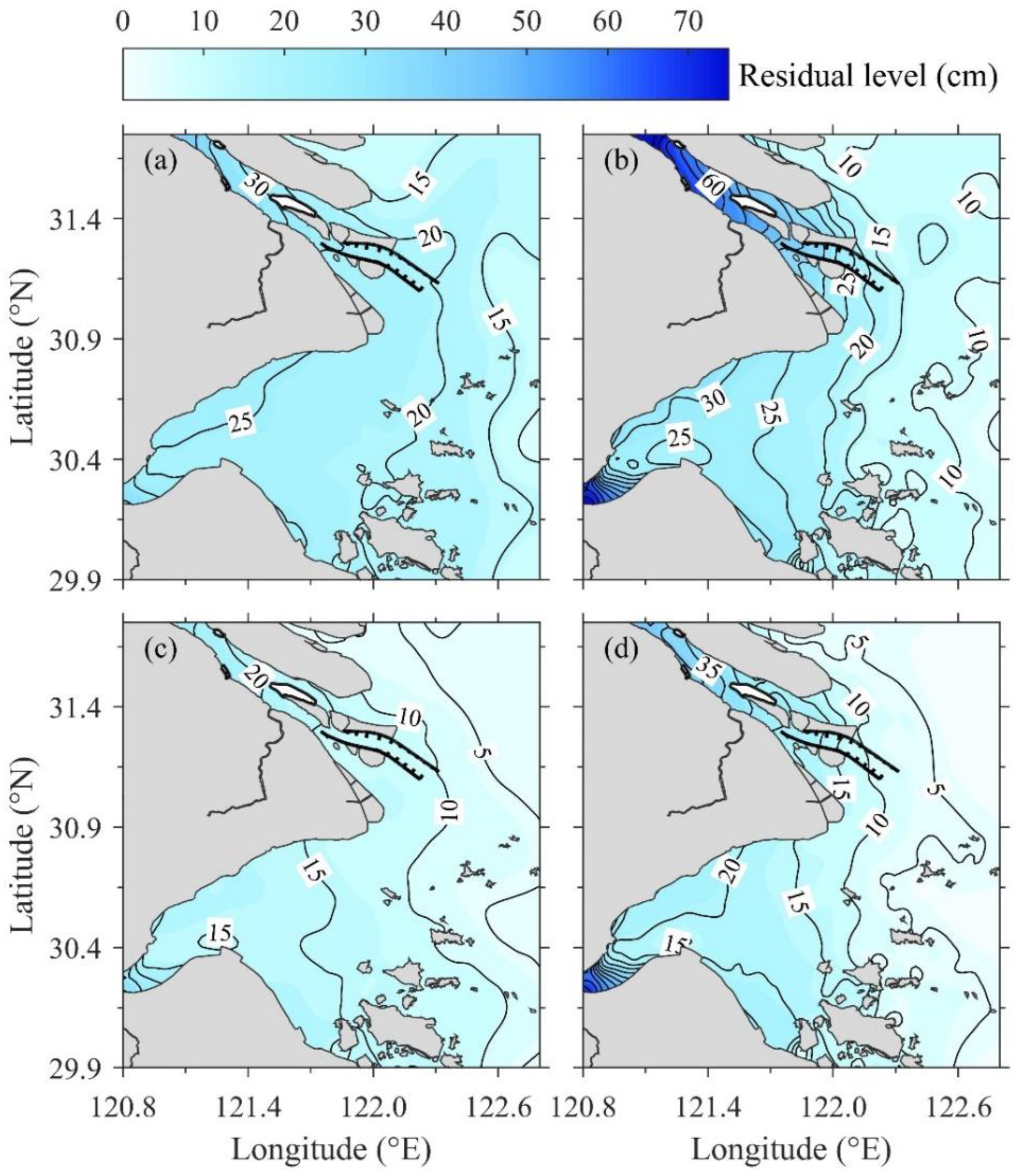
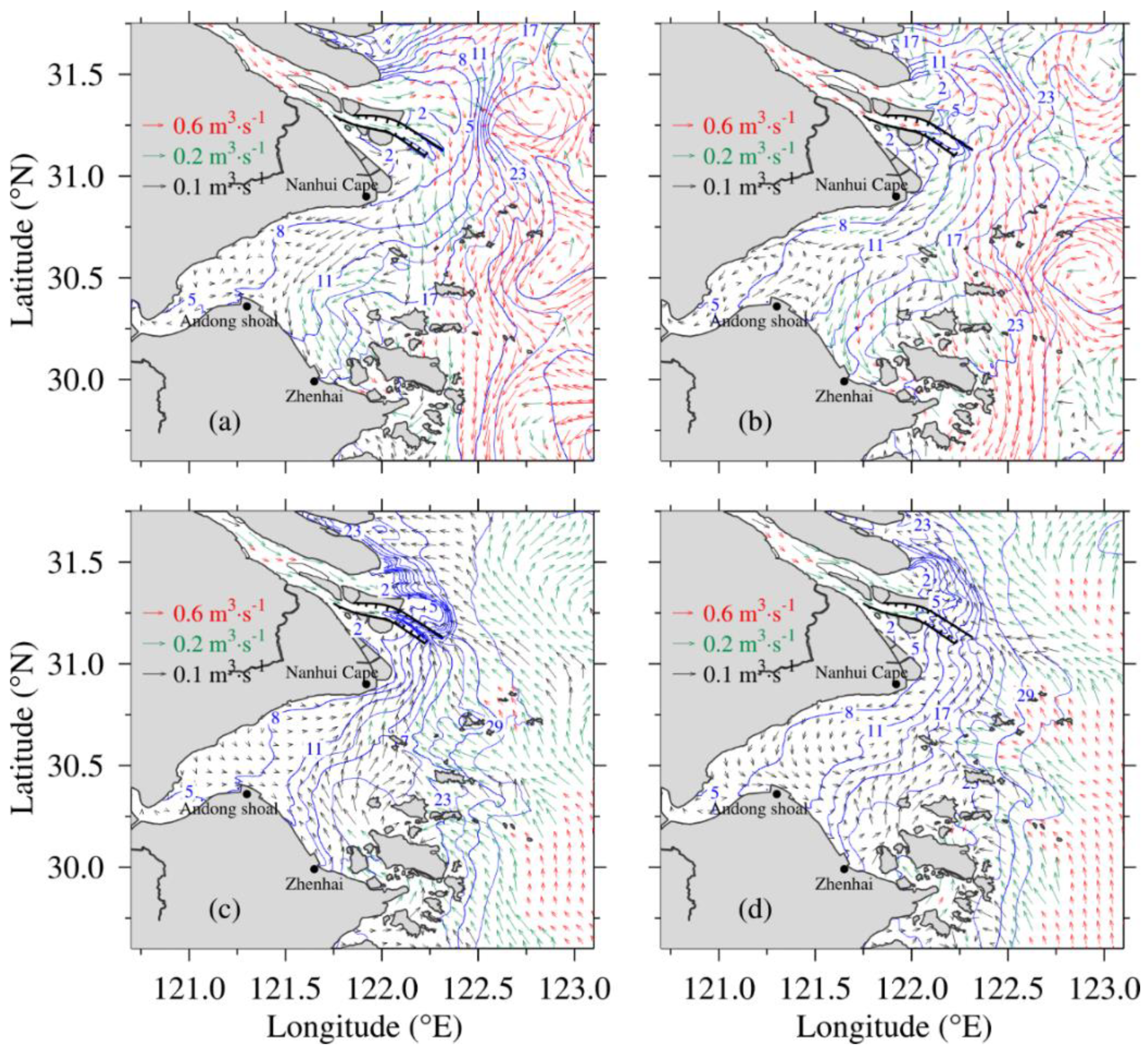

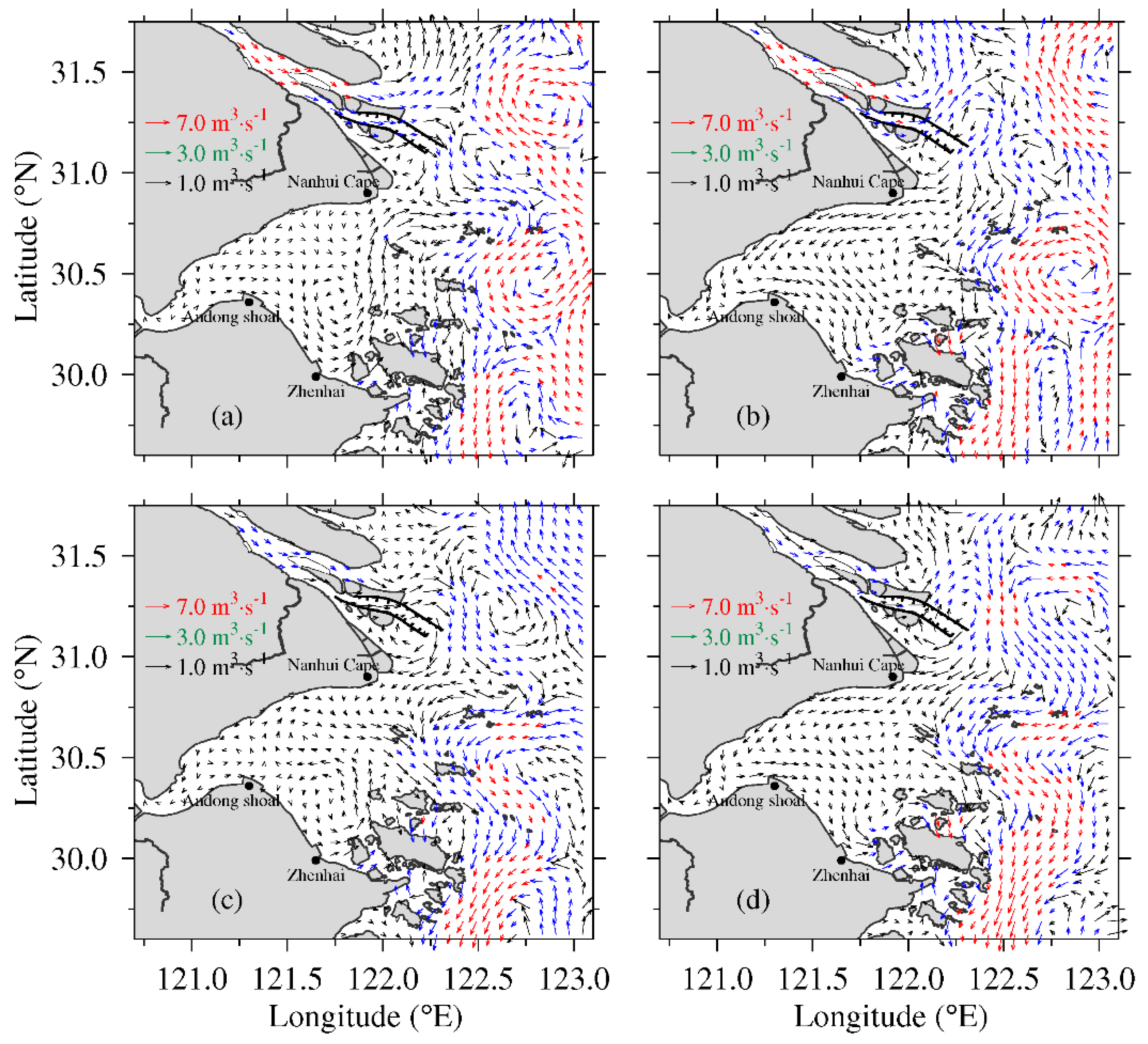
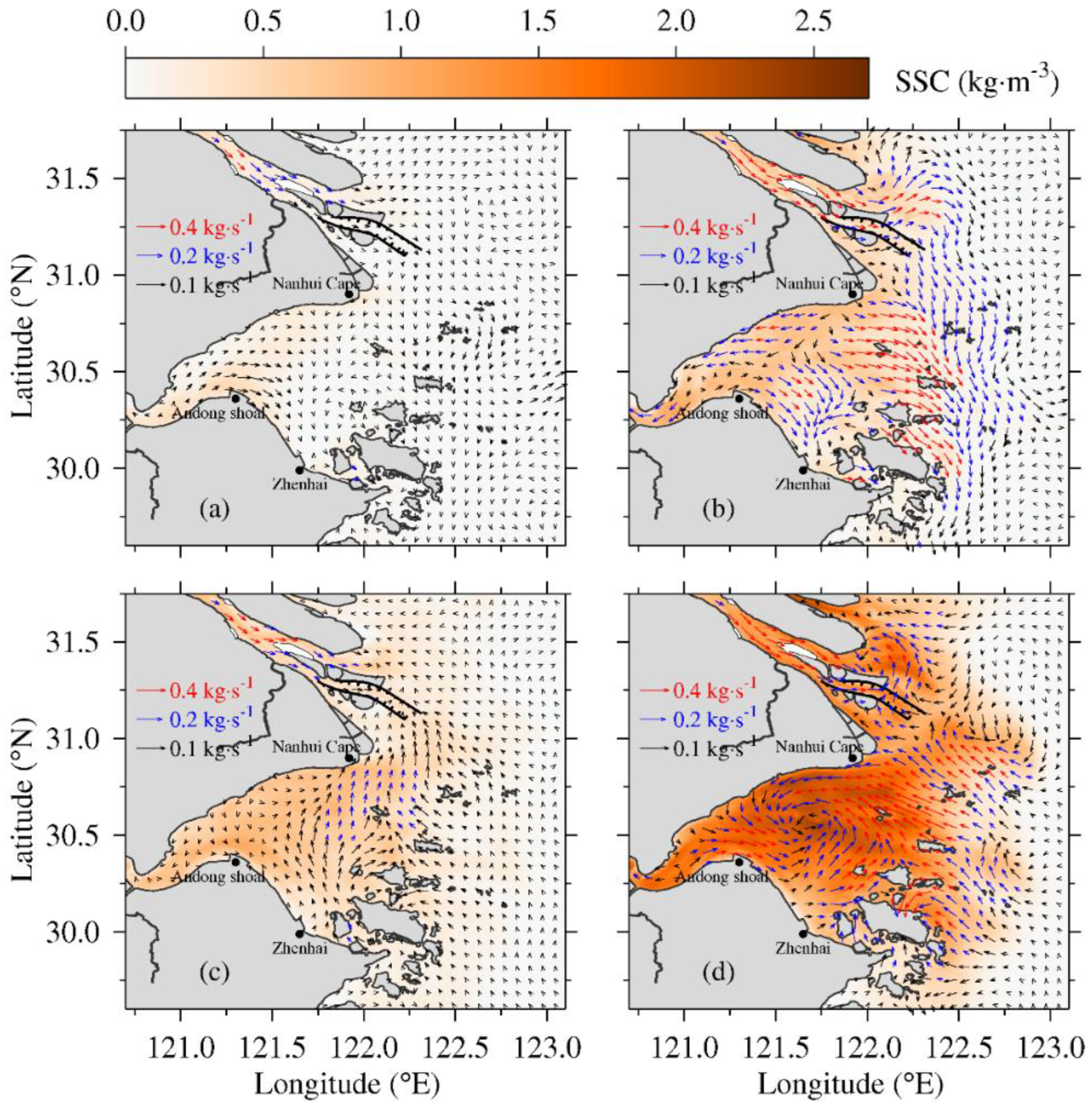
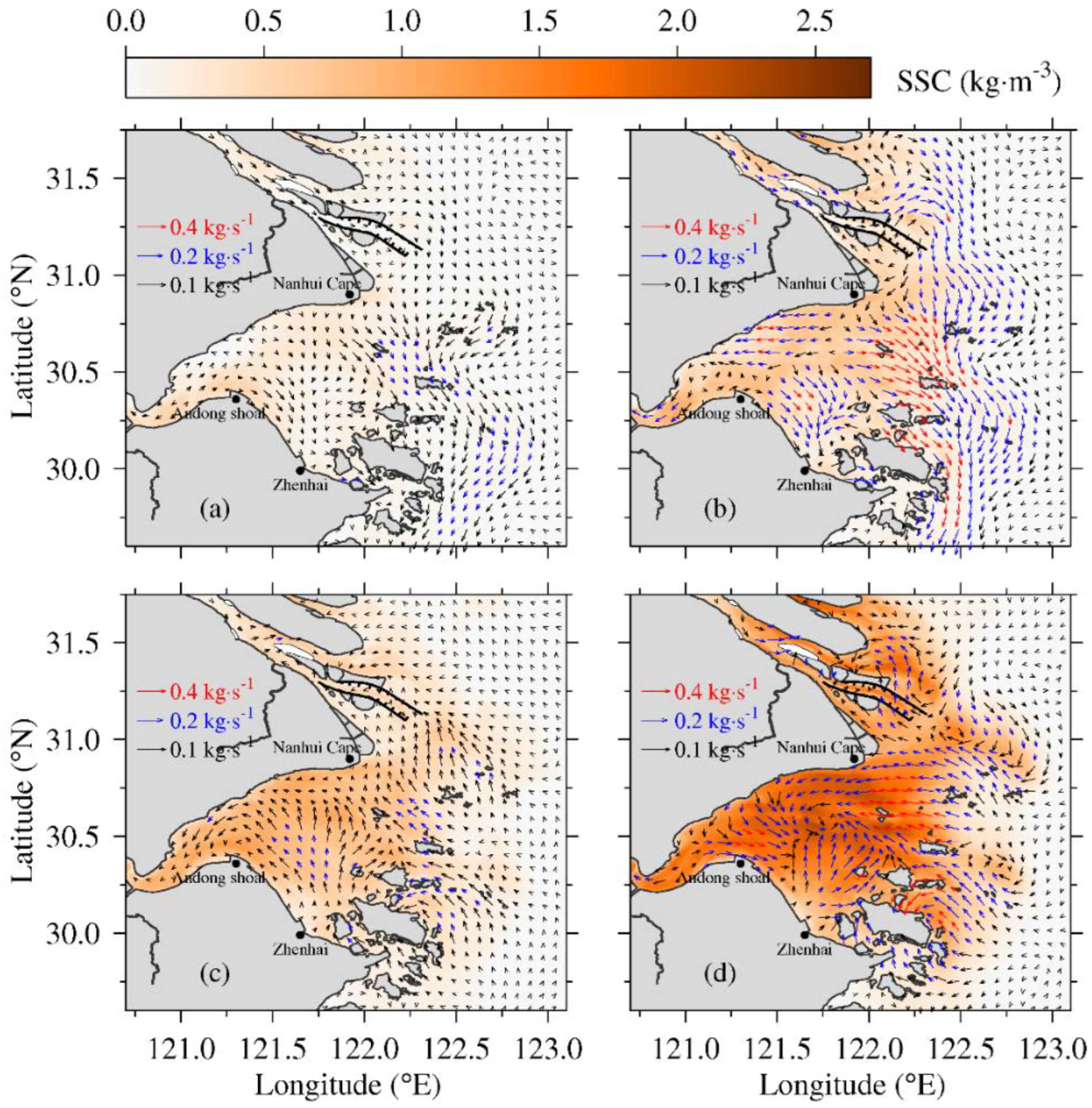
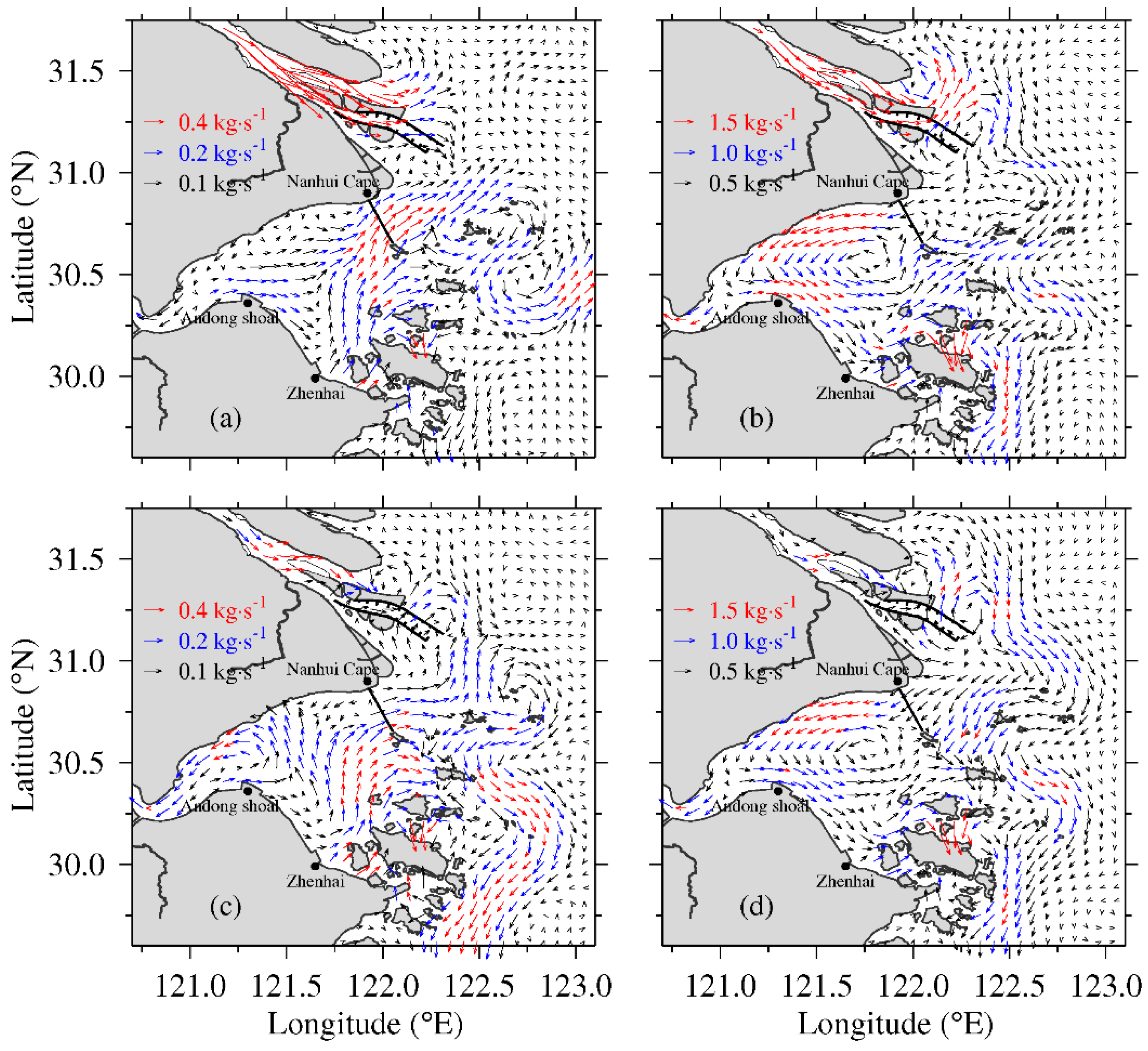
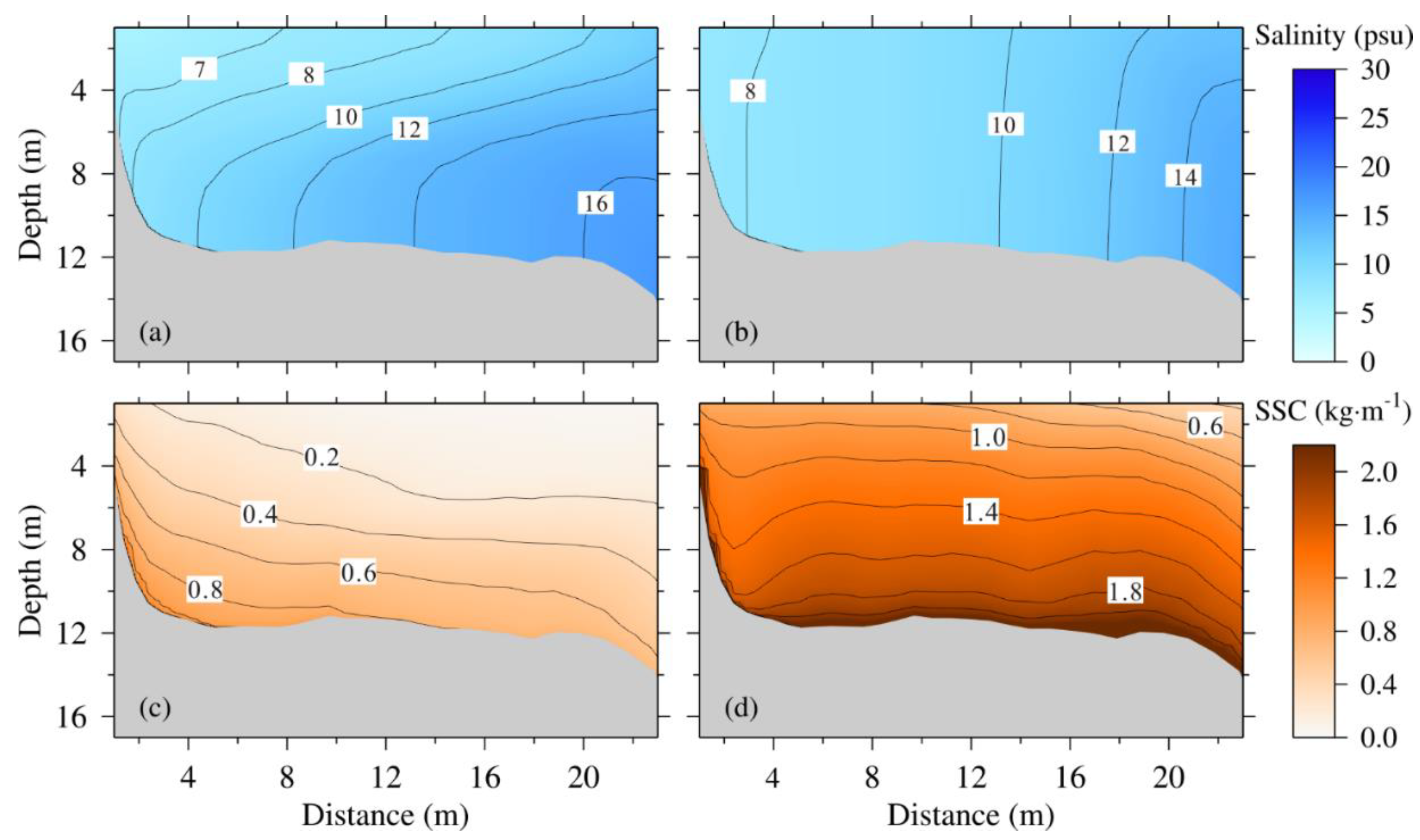
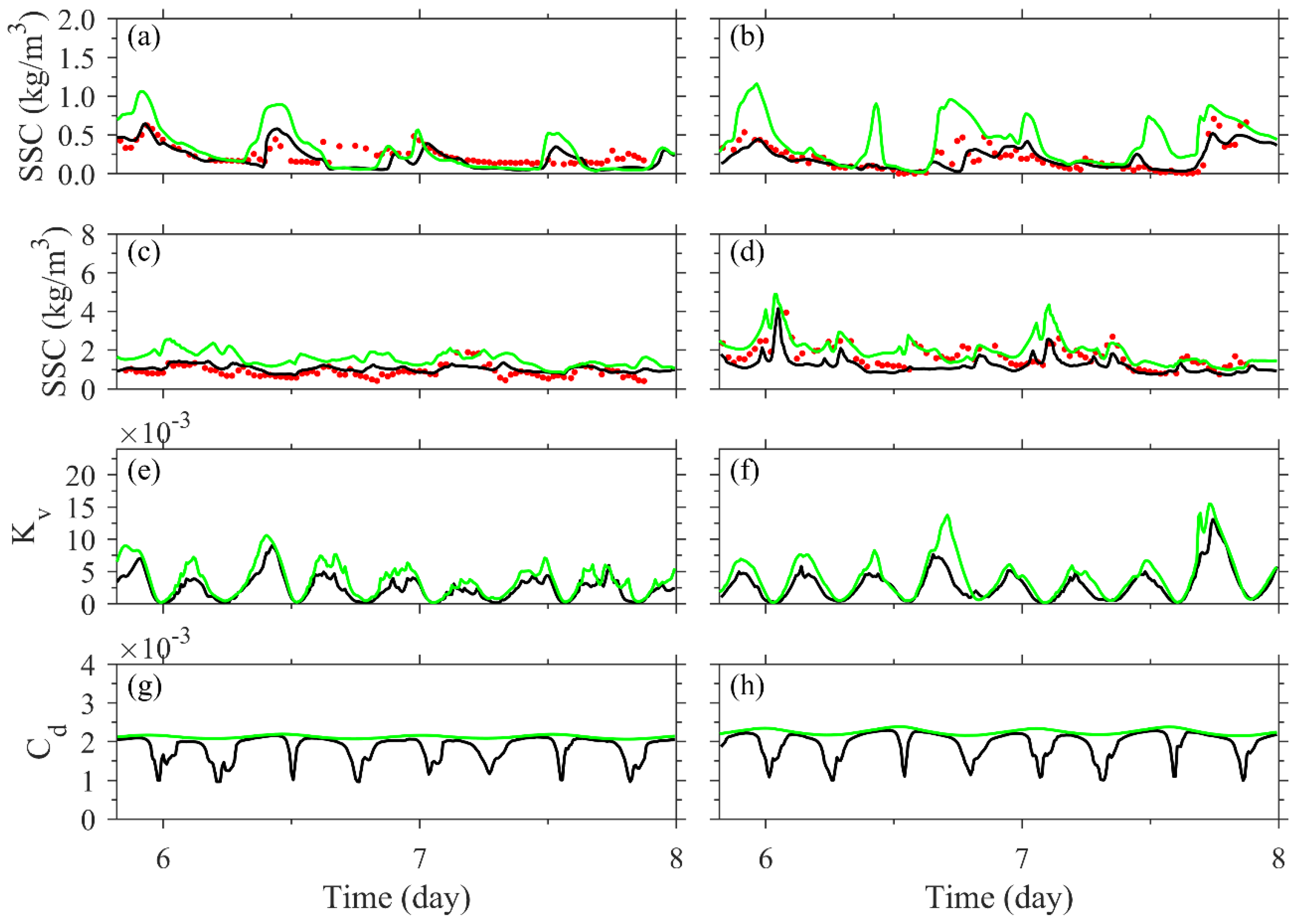
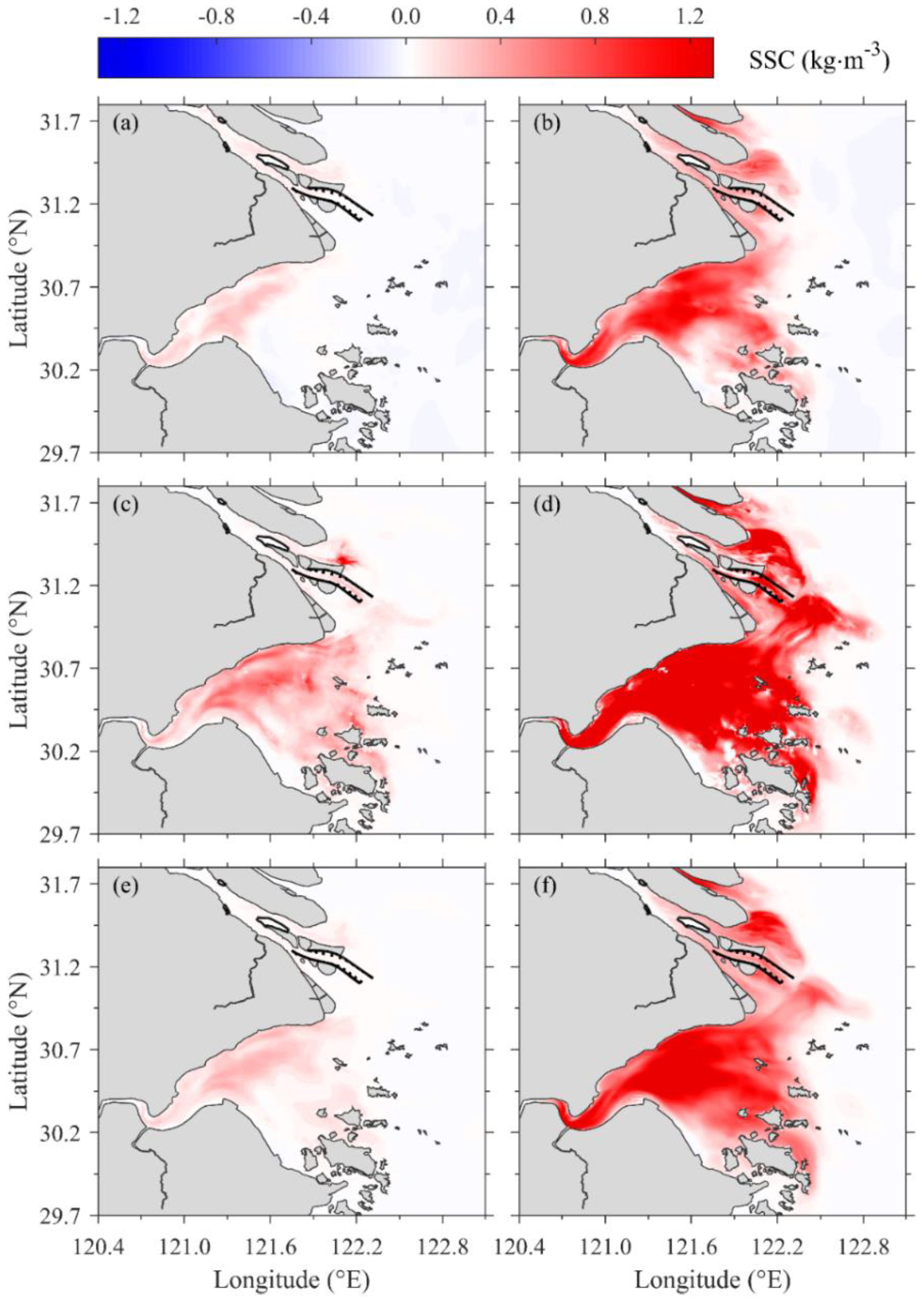
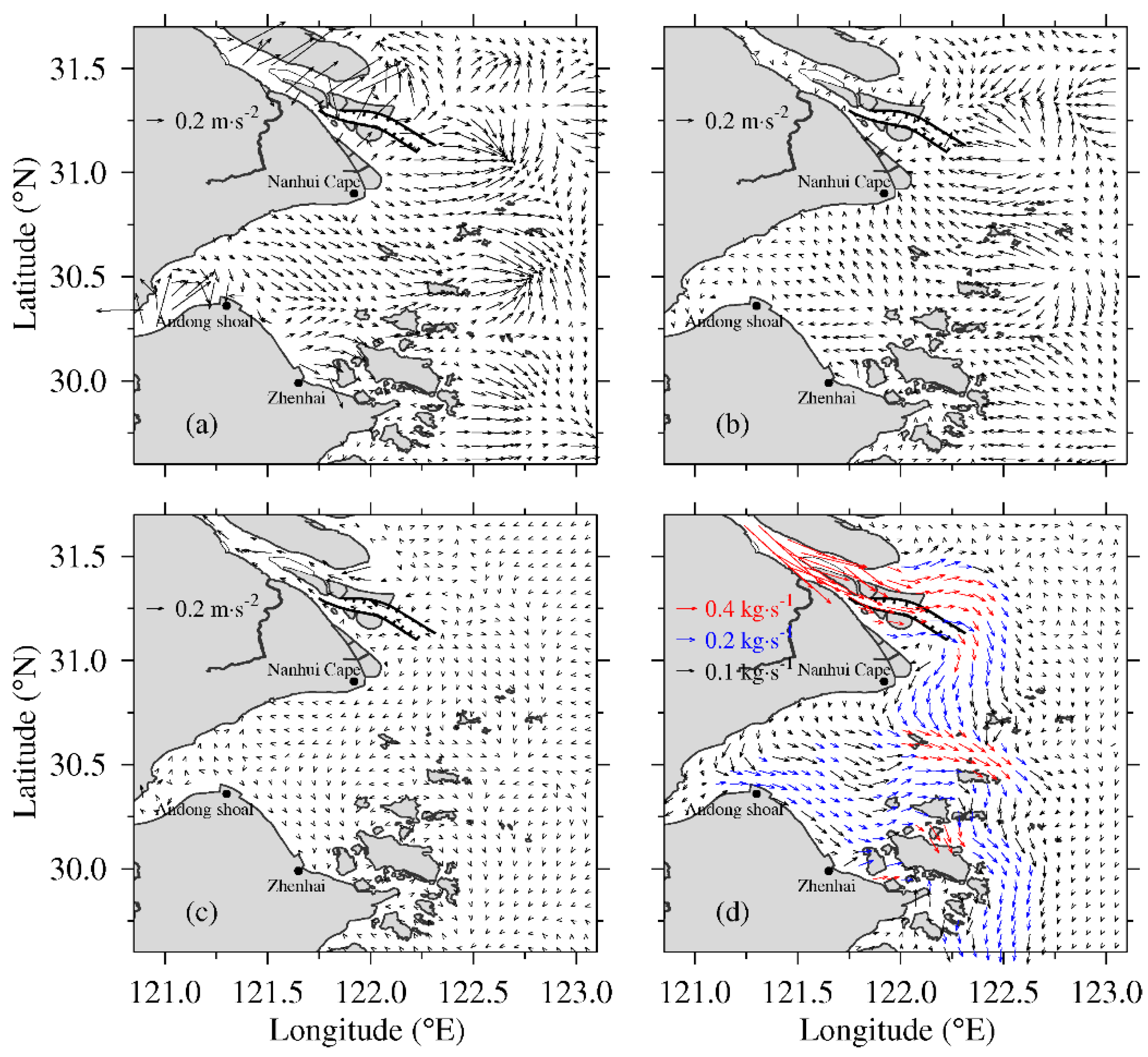
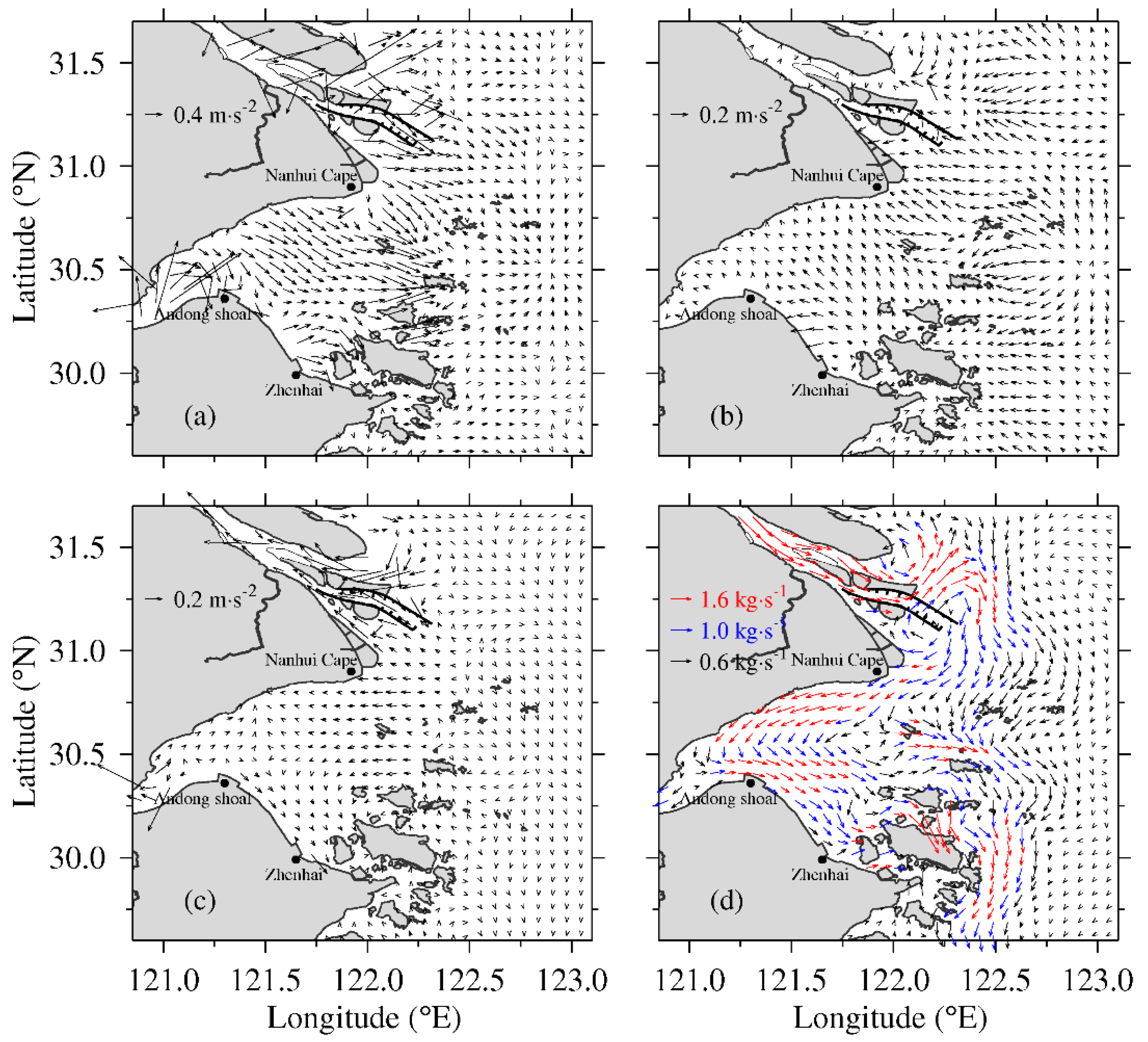
| Parameter | Value | Reference |
|---|---|---|
| M (kg·m−2·s−1) | 3.0 × 10−5 | Tested |
| 0.67 | Tested | |
| 0.30 | [52] | |
| 0.25 | [54] | |
| (m2·s−1) | 1.36 × 10−6 | [49] |
| ρs (kg·m−3) | 1250 | [72] |
| C0 (kg·m−3) | 0.20 | [65] |
| m1 | 0.10 | [73] |
| m2 | 6.20 | [73] |
| n1 | 1.20 | [73] |
| n2 | 1.60 | [73] |
| Skill Assessment | Site A | Site B | ||||
|---|---|---|---|---|---|---|
| CC | RMSE | SS | CC | RMSE | SS | |
| Surface velocity in the neap tide | 0.94 | 0.15 m/s | 0.97 | 0.94 | 0.15 m/s | 0.97 |
| Bottom velocity in the neap tide | 0.87 | 0.09 m/s | 0.92 | 0.94 | 0.07 m/s | 0.97 |
| Surface velocity in the spring tide | 0.93 | 0.22 m/s | 0.96 | 0.96 | 0.15 m/s | 0.98 |
| Bottom velocity in the spring tide | 0.90 | 0.15 m/s | 0.95 | 0.90 | 0.15 m/s | 0.94 |
| Surface salinity in the neap tide | 0.74 | 0.90 | 0.84 | 0.86 | 0.81 | 0.85 |
| Bottom salinity in the neap tide | 0.97 | 0.61 | 0.95 | 0.93 | 0.62 | 0.89 |
| Bottom salinity in the spring tide | 0.73 | 1.39 | 0.80 | 0.55 | 0.81 | 0.74 |
| Surface SSC in the neap tide | 0.64 | 0.12 kg·m−3 | 0.78 | 0.78 | 0.11 kg·m−3 | 0.87 |
| Bottom SSC in the neap tide | 0.47 | 0.31 kg·m−3 | 0.60 | 0.67 | 0.63 kg·m−3 | 0.64 |
| Bottom SSC in the spring tide | 0.63 | 1.19 kg·m−3 | 0.78 | 0.56 | 0.93 kg·m−3 | 0.75 |
| Phases | NTWF (109 m3) | NTSF (109 kg) |
|---|---|---|
| Spring tide in summer | −2.91 | −4.16 |
| Neap tide in summer | 4.29 | 2.44 |
| One month in summer | −7.81 | −4.80 |
| Spring tide in winter | −2.27 | −4.30 |
| Neap tide in winter | −0.16 | 0.93 |
| One month in winter | −13.4 | −21.6 |
Publisher’s Note: MDPI stays neutral with regard to jurisdictional claims in published maps and institutional affiliations. |
© 2022 by the authors. Licensee MDPI, Basel, Switzerland. This article is an open access article distributed under the terms and conditions of the Creative Commons Attribution (CC BY) license (https://creativecommons.org/licenses/by/4.0/).
Share and Cite
Huang, J.; Yuan, R.; Zhu, J. Numerical Simulation and Analysis of Water and Suspended Sediment Transport in Hangzhou Bay, China. J. Mar. Sci. Eng. 2022, 10, 1248. https://doi.org/10.3390/jmse10091248
Huang J, Yuan R, Zhu J. Numerical Simulation and Analysis of Water and Suspended Sediment Transport in Hangzhou Bay, China. Journal of Marine Science and Engineering. 2022; 10(9):1248. https://doi.org/10.3390/jmse10091248
Chicago/Turabian StyleHuang, Ju, Rui Yuan, and Jianrong Zhu. 2022. "Numerical Simulation and Analysis of Water and Suspended Sediment Transport in Hangzhou Bay, China" Journal of Marine Science and Engineering 10, no. 9: 1248. https://doi.org/10.3390/jmse10091248






